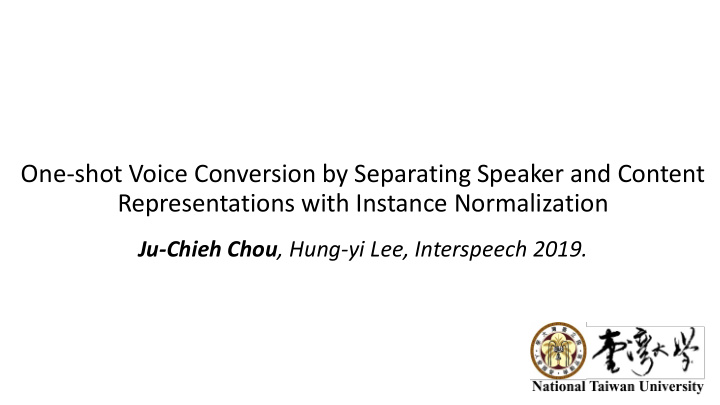



One-shot Voice Conversion by Separating Speaker and Content Representations with Instance Normalization Ju-Chieh Chou , Hung-yi Lee, Interspeech 2019.
Outline 1. Introduction 2. Proposed Approach • Model • Experiments 3. Conclusion
Outline 1. Introduction 2. Proposed Approach • Model • Experiments 3. Conclusion
Voice conversion Change the characteristic of an utterance while maintaining the ● language content the same. Characteristic: accent, speaker identity, emotion … ● This work: focuses on speaker identity conversion. ● Speaker A Speaker 1 Model How are you How are you
Conventional: supervised VC with parallel data Same sentences, different signal from 2 speakers. ● Formulated as a supervised learning problem. Speaker A ● Speaker 1 Problem: require parallel data, which is hard ● to collect. How are you How are you Parallel data Nice to meet you Nice to meet you I am fine I am fine
Recently: unsupervised VC with non-parallel data Trained on non-parallel corpus, which is more attainable. ● Prior work: utilize deep generative model, ex. VAE, GAN, cycleGAN. ● Problem: cannot convert to speakers not in the training data. ● Our goal: train a model which is able to convert to speakers not in ● the training data. Speaker 1 Speaker A Don ’ t have to speak same sentences.
Motivation ● Intuition: speech signals inherently carry both content and speaker information. ● Learn the content/speaker representation separately. ● Synthesize the target voice by combining the source content representation and target speaker representation. Target speaker representation Source speaker representation Encoder Decoder content How are you How are you representation: ” How are you ”
Outline 1. Introduction 2. Proposed Approach • Model • Experiments 3. Conclusion
Model overview One-shot VC: use a utterance from target speaker as reference, and ● synthesize this reference speaker ’ s voice. Idea: separately encode speaker and content information with some ● special designed layers.
Idea ● Speaker information - invariant within an utterance. ● Content information - varying within an utterance. Special Designed Layers: Feature map Channel Instance Normalization Layer: normalizing speaker IN ′ = 𝑁 𝑑 − 𝜈 𝑑 information ( 𝜈, 𝜏 ) while preserving content information. M 𝑑 𝜏 𝑑 Intuition: normalize global information out (ex. high frequency), retain 𝑈 𝑁 𝑑 changes over time. Average Pooling Layer: calculating speaker information ( 𝛿, 𝛾) . AVG 𝑢 ′ = 𝑁 𝑑 𝑈 𝑢=1 Adaptive Instance Normalization Layer: provide speaker 𝑁 𝑑 − 𝜈 𝑑 AdaIN ′ = 𝛿 𝑑 information (𝛿, 𝛾) . M 𝑑 + 𝛾 𝑑 𝜏 𝑑
Model - training Problem: how to factorize the representations? S peaker AVG 𝑨 𝑡 Encoder 𝐹 𝑡 𝑦 𝑦 AdaIN Content Decoder 𝑨 𝑑 IN Encoder 𝐹 𝑑 D calculating speaker information( 𝛿, 𝛾 ). AVG IN normalizing speaker information ( 𝜈, 𝜏 ) while preserving content information. provide speaker information ( 𝛿, 𝛾 ). AdaIN
Model - testing Target speaker ’ s utterance S peaker AVG 𝑨 𝑡 Encoder 𝐹 𝑡 𝑦 𝑦 Converted AdaIN Content Decoder 𝑨 𝑑 IN Encoder 𝐹 𝑑 D Source speaker ’ s utterance calculating speaker information( 𝛿, 𝛾 ). AVG IN normalizing speaker information ( 𝜈, 𝜏 ) while preserving content information. provide speaker information ( 𝛿, 𝛾 ). AdaIN
Experiments – effect of IN Train another speaker classifier to see how much speaker information ● in content representations. The lower the accuracy is, the less speaker information it contains. ● Content encoder + IN: less speaker information. ● Speaker 𝑨 𝑑 (content Predict representation) speaker Classifier 𝑭 𝒅 With IN 𝑭 𝒅 Without IN Acc. 0.375 0.658
Experiments – speaker embedding visualization • Does speaker encoder learns meaningful representations? • One color represents one speaker ’ s utterances. • 𝑨 𝑡 from different speakers are well separated. S peaker Unseen speakers ’ AVG 𝑨 𝑡 Encoder 𝐹 𝑡 utterances
Experiments - subjective • Ask subjects to score the similarity between 2 utterances in 4-scales.
Experiments - subjective • Ask subjects to score the similarity between 2 utterances in 4-scales. • Our model is able to generate the voice similar to target speaker ’ s.
Demo page: https://jjery2243542.github.io/one-shot- vc-demo/ Demo (unseen) Male to Male Source: Target: Converted: Female to Male Source: Target: Converted:
Conclusion • We proposed a one-shot VC model, which is able to convert to unseen speaker with one reference utterance. • By IN and AdaIN, our model is able to learn factorized representations.
Thank you for your attention.
Recommend
More recommend